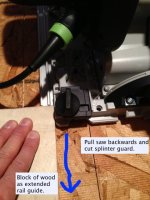I'm new to Festool and these forums. I bought a TS75 and want to trim the rubber splinter guard on the guide rail, but I have a few questions about how to do that.
I've searched these forums and read several good posts regarding trimming the splinterguard. One of those posts made me aware of the contradictory directions Festool gives for trimming. The online manual for my TS75 says to set the speed to 6, place the saw on the rear of the guard rail, turn the saw on, press it down to the cutting depth, and trim it along the full length without interruption.
The online manual for the TS55 gives much more specific instructions. But it recommends setting the speed to 1. It also recommends a shallow cutting depth (which the TS75 manual does not mention) of 6-7mm so that the blade teeth penetrate by about half a tooth. It further recommends having the splinter guard hanging over the edge so you don't cut the table (again, the TS75 manual makes not mention of this).
(1.) I read a post from Bob Marino recommending the slow speed setting ("1") over the fast ("6"). Am I correct in presuming this applies equally to the TS75?
(2.) Should I leave the strip hanging over the edge when I trim it (as the TS55 manual recommends)? It seems to me that it would be better to have it fully on a scrap piece to support it while trimming it. Would this choice affect the recommended speed for trimming the guard strip or the recommended depth of cut setting?
(3.) Since this cut must begin at the very rear of the rail to trim the entire strip at once, am I correct in presuming that you begin the cut by plunging into the strip?
(I ask this third question because a Festool rep recommended not beginning regular cuts by plunging. To this end, he recommended having at least 110" of rail to trim 8' lengths so that the saw could be fully plunged on the rail before beginning to cut.)
I'd appreciate any answers to these questions, and any other advice/tips you can give (including why the directions vary in the two manuals).
...
I've searched these forums and read several good posts regarding trimming the splinterguard. One of those posts made me aware of the contradictory directions Festool gives for trimming. The online manual for my TS75 says to set the speed to 6, place the saw on the rear of the guard rail, turn the saw on, press it down to the cutting depth, and trim it along the full length without interruption.
The online manual for the TS55 gives much more specific instructions. But it recommends setting the speed to 1. It also recommends a shallow cutting depth (which the TS75 manual does not mention) of 6-7mm so that the blade teeth penetrate by about half a tooth. It further recommends having the splinter guard hanging over the edge so you don't cut the table (again, the TS75 manual makes not mention of this).
(1.) I read a post from Bob Marino recommending the slow speed setting ("1") over the fast ("6"). Am I correct in presuming this applies equally to the TS75?
(2.) Should I leave the strip hanging over the edge when I trim it (as the TS55 manual recommends)? It seems to me that it would be better to have it fully on a scrap piece to support it while trimming it. Would this choice affect the recommended speed for trimming the guard strip or the recommended depth of cut setting?
(3.) Since this cut must begin at the very rear of the rail to trim the entire strip at once, am I correct in presuming that you begin the cut by plunging into the strip?
(I ask this third question because a Festool rep recommended not beginning regular cuts by plunging. To this end, he recommended having at least 110" of rail to trim 8' lengths so that the saw could be fully plunged on the rail before beginning to cut.)
I'd appreciate any answers to these questions, and any other advice/tips you can give (including why the directions vary in the two manuals).
...

